1.Introduction
SHEIN, an online fast fashion retailer based in Singapore, is one of the best-known e-commerce platforms worldwide. Its predecessor is SheInside, a cross-border wedding dress e-commerce company founded by Chris Xu in Nanjing, China 2008. SHEIN has opened the market in more than 150 countries and regions worldwide as a fast fashion consumer to win young consumers' love. Engaged primarily in Men's & women's children's clothes, accessories, bags, shoes, and SHEIN houses and specialized in Women.
This paper aims to summarize, analyze, and elaborate on the dimensions of SHEIN's brand image and incorporate them into the perspective of brand communication. It mainly discusses the brand image characteristics reflected in SHEIN's YouTube comments from December 2021 to July 2023. The research dimension of brand image is more in line with the scientific nature of the brand, that is, communication. From the perspective of brand communication, brand image is one of the essential elements in the process of brand development because the formation of brand image is not only for the purchase of products but, more importantly, brand image is also related to how consumers as the target audience of communication interpret (decode) brand information and realize brand information in life. Wijaya, B. S. [1]
The academic research field of brand image and communication is generally a general theoretical summary, but there are few detailed studies on specific brands. Based on existing research theories, this paper will analyze the information published by SHEIN's official media on YouTube and related evaluations, explore the characteristics of SHEIN's brand image from the perspective of brand communication, and formulate brand image communication strategies.
2.Literature Review
2.1.Concept of Brand and Brand Communication
The American Marketing Association (AMA) defines a brand as "a unique combination of name, term, sign, symbol, or design aimed at distinguishing the offerings of one seller or group from others in the market.” Kottler, P. [2]. This concept resonates with Aaker’s idea that a brand is a distinctive marker, whether through a logo, stamp, or packaging, signifying a particular seller's goods or services. Aaker, D. A. [3]. Kottler posits that a robust brand bolsters a company's reputation, acting as the initial touchpoint for consumers to recognize products. Kottler, P. [2]. At its heart, a brand embodies the consistent promise of vendors, delivering a specific range of performance, advantages, and value to consumers. Wijaya, B. S. [1]
From a communicative lens, Wijaya perceives a brand not merely as a tangible logo or symbol but as an indelible impression on the consumer's mind and emotions, evoking specific sentiments and connotations. Wijaya, B. S. [4] . To this end, a brand transcends its physical representation, morphing into a pledge and a bond founded on trust. It represents the entirety of an entity, fostering a psychological connection that drives customer loyalty and embodies the perceived added value. Building on this, Nilson highlights that a brand is not confined to its nomenclature. Nilson, T. H. [5]. Instead, it must offer unmistakable value, carve out its unique space amidst competitors, resonate with its audience, and boast a distinct identity.
2.2.Theoretical Guidance
2.2.1.Hierarchy of Branding
From the perspective of brand communication, the formation process and effect of a brand have a certain level, which also shows the relationship between the development of a brand and its proximity to consumers. This level is called the hierarchy of branding. Wijaya, B. S. [1].
Figure 1: Hierarchy of Branding. Wijaya, B. S. [4].
Upon its initial launch, a brand is in the phase of building consumer recognition. At this stage, referred to as Brand Awareness, consumers might have minimal knowledge or knowledge of the brand's existence. As the brand becomes more recognized and its attributes and benefits get familiarized by the consumers, it transitions to the Brand Knowledge phase. Now, consumers are no longer simply aware of the brand; they begin to understand and learn more about the product or the brand itself. Over time and through continuous engagement, consumers start forming associations and specific perceptions about the brand. This accumulated mental image of the brand in the consumers' minds is what we refer to as the Brand Image. With further passage of time and ongoing interactions, consumers may try the products or come into direct contact with the brand. This exposure provides them with specific experiences that form new connotations and emotions linked with the brand and reinforce its image. This is the Brand Experience phase. When a positive image and memorable experiences contribute to a significant and unique feeling about a brand, it solidifies its position in consumers' minds and hearts. This leads to enhanced brand equity, making the brand more likely to be preferred by consumers. Such a brand, favorably positioned and having substantial equity, can secure consumer loyalty, making it difficult for consumers to shift their preference to other brands. This phase is identified as Brand Loyalty.
Finally, the relationship between a consumer and a brand might deepen to the point where consumers demonstrate loyalty and develop a potent affiliation with the brand. This brand becomes an integral part of their life values, impacting their worldview. This stage, where consumers extract spiritual satisfaction and life values from their cherished brand and endeavor to share and broadcast these to other consumers, is called Brand Spirituality. This way, more consumers can partake in similar experiences, become part of a larger ecosystem influenced by the brand, and cultivate shared happiness within a tight-knit community. So, from Brand Awareness to Brand Image, the goal is to capture mindshare. Brand Experience is about securing market share, Brand Loyalty aims for heart share, and Brand Spirituality strives for social share.
2.2.2.Brand Image
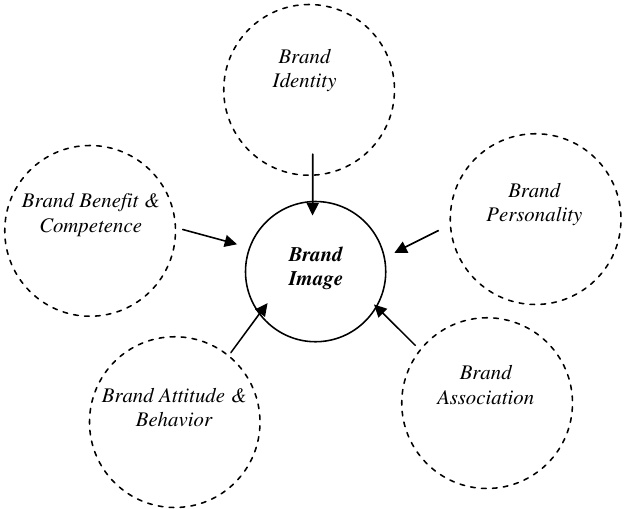
Figure 2: Brand Image. Wijaya, B. S. [1].
(1) Brand Identity
The first dimension is brand identity. This refers to the concrete or discernible characteristics of a brand or product, allowing consumers to effortlessly identify and differentiate it from its counterparts in the market.
(2) Brand Personality
A brand's distinct character, much like human personality traits, enables consumers to easily set it apart from others within its category. As highlighted by Aaker, there are various facets to brand personality, including competence, sincerity, excitement, sophistication, and ruggedness. Aaker, D. A. [3].
(3) Brand Association
Brand associations are specific elements or activities consistently linked with a brand. These could stem from unique product offerings, regular and consistent actions such as sponsorships or social responsibility initiatives, strongly related issues, or even certain symbols and meanings intimately tied to a brand. Sometimes, it could even be someone who has an influential association with a brand.
(4) Brand Benefit and Competence
Brand Benefit and Competence entails the value and benefits consumers receive from the products and services of a certain brand. Brand Benefit and Competence is not only limited to material benefits but also include psychological and symbolical values and benefits.
(5) Brand Image in Brand Communication
Brand image is pivotal in brand development, serving as a barometer for its reputation and trustworthiness. This image acts as a beacon, guiding potential consumers in deciding to try or engage with a particular product or service. When consumers interact with the brand, they undergo a 'brand experience.' This experience is crucial in discerning whether the consumer will remain loyal or is merely an opportunist, likely to switch at the next best offer. Brand image is essentially the collective perception formed through accumulated information and knowledge about the brand. It plays an instrumental role in shaping consumers' attitudes, beliefs, and preferences regarding brand selections.
3.Research Design and Methods
3.1.Data Collection
The research is based on qualitative data from YouTube, specifically, the comments posted under videos about SHEIN. We used YouTube’s YouTube Data API V3 to collect the original statement and publishing date. In the end, we collected 3000 pieces of comments. YouTube comments offer several advantages over traditional surveys. The inherent accessibility associated with YouTube videos enables their consumption by a diverse audience. This broad viewership demographic, in turn, amasses a large and varied data set.
Additionally, the diversity in the data ensures the mitigation of potential biases that could otherwise influence the findings. YouTube allows us to collect data from audiences spanning diverse geographical and socioeconomic backgrounds; regional bias, which might afflict traditional surveys distributed in a confined area, is effectively eliminated. As a result, leveraging YouTube comments as a data source ensures that a diverse group of people is represented in the research outcome.
3.2.Data Analysis
We used the MDCOR software to analyze the YouTube comments we collected. Initially, we trim words unrelated to our analysis, then we execute a metrics plot to determine the number of topics discussed in the comments. As shown in Figure 3, the metrics plot indicates that the comments mainly discuss three distinct topics.
We then separate the comments into 3 different groups based on topics, which allows us to transform a relatively large data set into manageable groups of comments that will be easier to analyze. The MDCOR then filters out the most representative comment from each topic. Each of the representative comment generalizes the discussion within that topic and include the elements that people often associate with the brand when discussing the topic. As indicated by Figure 2, Brand association an important component of the overall brand image, therefore, we can get a sense of public perception toward SHEIN from the analysis of representative comments.
Each of the representative comments represents the public’s perception toward a certain aspect of SHEIN. The combination of these three topics will give us the overall perception.
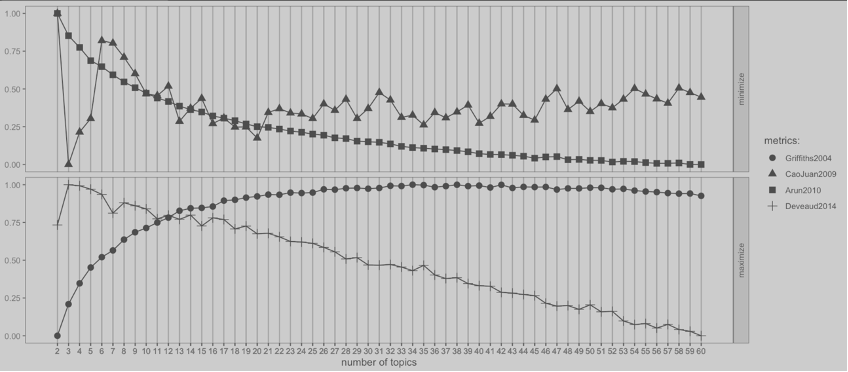
Figure 3: Metrics Plot
3.3.Results
Discussion on topic 1 is concerned with the broader implications of the fast-fashion trend Shein introduces. The cheap prices of Shein product creates a fast fashion trend where consumers buy an excessive amount of trendy clothing. Online social media exacerbates the consumption of fast fashion, teenagers buy fashionable clothing from Shein to appear as “cool” on platforms like Tik Tok. They will be motivated to buy more fast fashion products by the false accolades they receive from other users, thus starting a malicious cycle of never-ending consumption of fast fashion. For fast fashion addicts, their purchase is not motivated by necessity but rather a feeling of vanity that drives them to make unconscious purchasing decisions to buy Shein clothing garments that they would only wear for once or twice. The overconsumption of fashion garments means that fashion garments are thrown away and replaced at a rate unsustainable for our environment.
Discussion on topic 2 pertains to the quality of SHEIN garments. The quality of SHEIN products is often associated with keywords such as "cheap" and "terrible," both of which indicate poor quality. The low prices of SHEIN garments are unable to justify their poor quality. This is because the inferior quality of SHEIN garments not only affects consumer experience but also directly detracts from the value of the garment by shortening its lifetime. Thus, due to the low quality of the garment, consumers need to replace it more often than good quality garments, and in the long run, the value of SHEIN garments is less than that of good quality garments. The poor quality of SHEIN garments is a cause for concern as it affects the consumer experience and the value of the garment. Therefore, it is necessary to address the issue of poor quality in SHEIN garments to ensure that consumers receive high-quality products that provide value for money.
The third topic includes a discussion pertains to the unethical practices exhibited by SHEIN. The discussion highlights SHEIN's apparent violation of local labor laws, as Shein factory workers are compelled to work overtime for at least 45 hours per month without additional pay. However, due to the scale of Shein's operations, regulators have chosen to overlook these violations. Furthermore, the discussion underscores Shein's abuse of non-compete agreements, which prohibit its workers from working in similar jobs in China, thereby preventing them from leaving their low-paying jobs. Additionally, the discussion highlights discrimination in Shein's hiring process, where the company prioritizes applicants from non-democratic countries to work in its Western offices. This is due to the belief that citizens in non-democratic countries are accustomed to unfair treatment and would be more tolerant of unlawful treatment, such as overtime, from Shein.
Consequently, Shein's unethical practices have resulted in protests against the brand, which have negatively impacted the company's revenue and overall brand image.
In conclusion the discussion about SHEIN is mainly negative. SHEIN has been mainly associated with undesirable elements such as fast fashion and unethical practices. Brand benefit & competence for SHEIN is negative since its product offer little value for its consumers. According to Figure 2, both brand association and Brand benefit & competence are important factors contributing to Brand Image. Shein’s reluctance to address these two issues have detrimental effects on SHEIN’s overall brand image.

Figure 4: Most Representative Comment from Topic 1
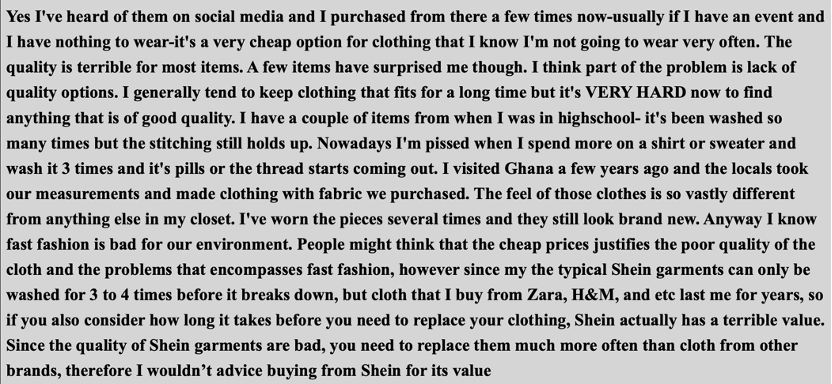
Figure 5: Most Representative Comment from Topic 2
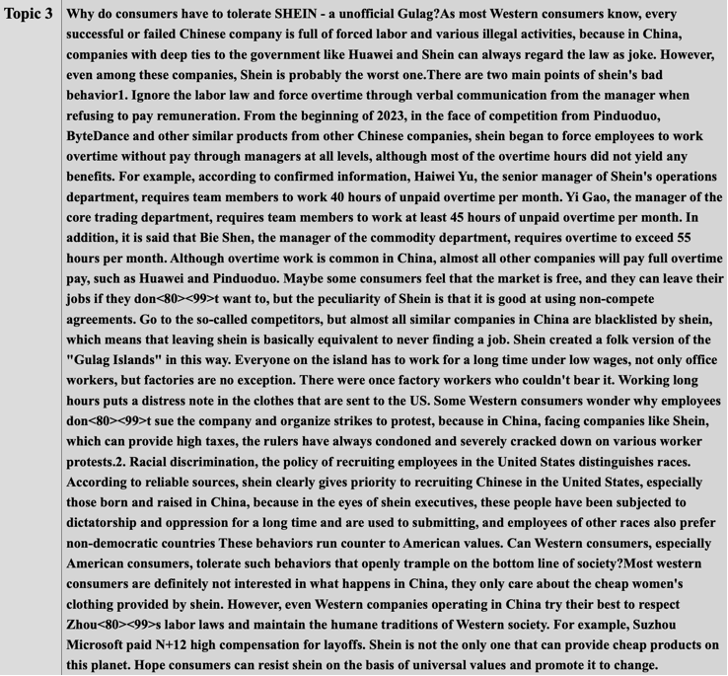
Figure 6: Most Representative Comment from Topic 3
4.Conclusion
Brand image plays an essential role in brand development because brand image affects brand reputation and credibility and later becomes a "guide" for consumer audiences to try or use a product or service, which then generates a specific experience (brand experience), which Will determine if consumers will be brand loyal or just be opportunistic (easily switch to another brand). Brand image, including product brand, personal brand, institution, or corporate brand, is formed by various individual factors from the self-consumer or audience and environmental factors outside the consumer or audience. These multiple factors are expressed through the main dimensions that represent and shape the brand image, which includes the identity dimension (brand identity), the personality dimension (brand personality), the association dimension (brand associations), the attitude and behavior dimensions (brand attitudes and behaviors), and Product, individual or institution/company benefits, strengths, and capabilities dimensions (brand benefits and capabilities). With the clarity of these dimensions, researchers and decision-makers can measure and see how strong a product, individual, or institution/company's brand image is by measuring and evaluating the above dimensions. The more substantial and positive these dimensions are in the minds of the consumer audience, the stronger and more positive the product's brand image, individual, or institution/company will be.
As mentioned above, brand identity refers to the physical or tangible identity associated with a brand or product, making it easy for consumers to identify and distinguish from other brands or products, such as logos, colors, packaging, location, corporate logos, slogans, etc. By checking SHEIN's official website, you can see that SHEIN's brand statement is: "SHEIN is a global fashion and lifestyle e-retailer committed to making the beauty of fashion accessible to all. We use on-demand manufacturing technology to connect suppliers to our agile supply chain, reducing inventory waste and enabling us to deliver various affordable products to customers worldwide. From our global offices, we reach customers in more than 150 countries." By reading this passage. We can distill keywords such as "beauty," "accessible," "agile," "affordable," "global," etc. These are the "official slogans proposed by the brand" mentioned in the brand logo, symbolizing the brand highlights and characteristics created by SHEIN. These keywords that represent the SHEIN brand identity happen to be the keywords "quality" and "cheap" (corresponding to "affordable") and "fast" (corresponding to "agile") extracted from YouTube. From this point of view, SHEIN's official slogan is consistent with consumer perception. In addition, the logo in black and white capital letters is straightforward, which is conducive to consumers' initial memory of the brand. All this is enough to show that SHEIN's brand identity is very distinctive and unique.
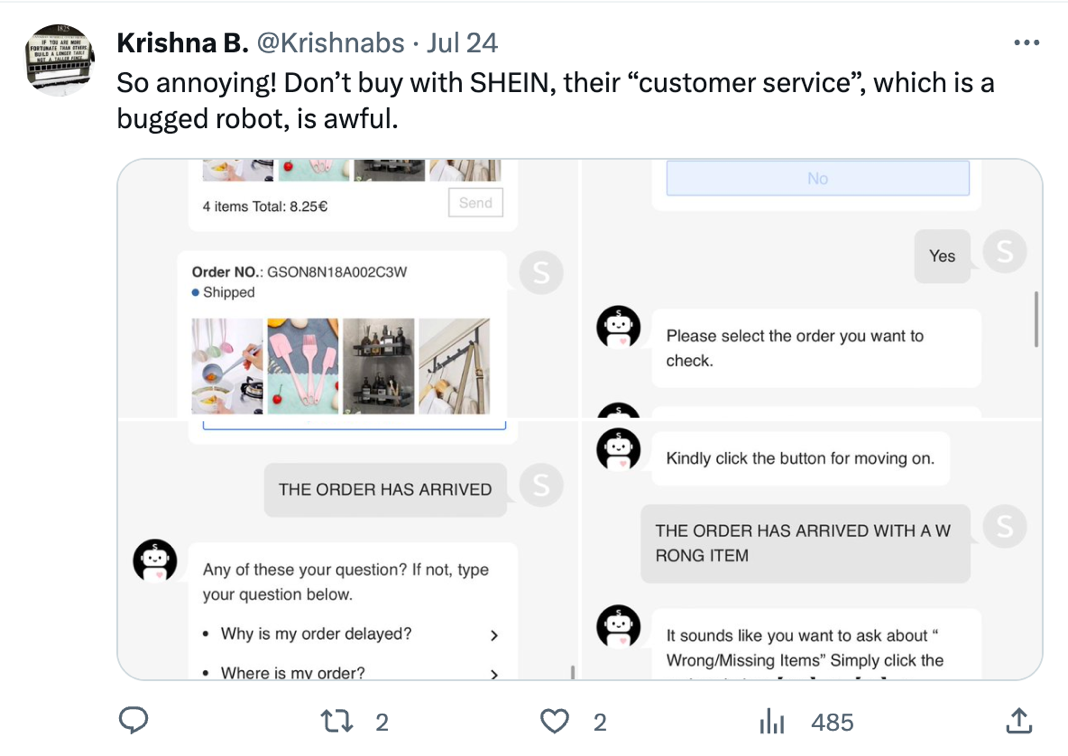

Figure 7: Comments from Twitter

Figure 8: Comments from YouTube
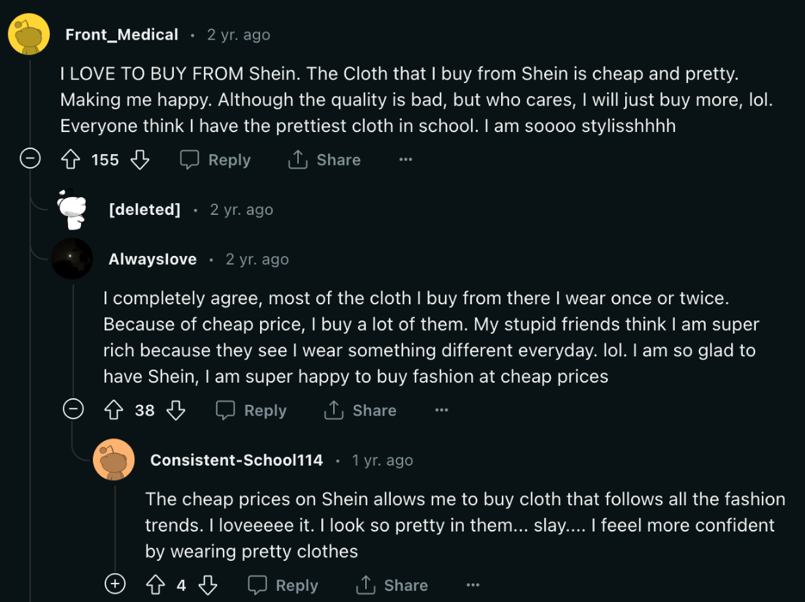
Figure 9: Comments from Reddit

Figure 10: Comments from YouTube
It is hard to find reviews that talk directly about the "humanity" of a brand when it comes to personality, whereas the word "bad" is the word that appears more often and comes closest to personality. The comments focused on allegations of poor customer service at SHEIN and some controversial issues such as "environment," "labor," and "plagiarism." At the same time, it also confirms the brand association with SHEIN because whether it is directly searched through the search engine or browsing relevant comments about SHEIN on social media, there are controversial issues about the environment, labor, sustainability, etc. Therefore, for the association of the SHEIN brand, not only summarize the keywords in the comments but also observe a series of behaviors made by the brand. For example, the brand owner must publicize or refute rumors effectively in a dispute. Otherwise, it will significantly damage the brand's public image. To speed up the schedule of brand listing, SHEIN accepted an exclusive interview with the media in the second half of 2022 in response to long-standing doubts. Leonard, a public relations management expert hired by SHEIN to respond to the interview, needed to clarify the problems in SHEIN. However, he expressed SHEIN's requirements and continuous efforts in supplier management and environmental protection.
In addition, SHEIN's customer service problems needed to be handled promptly, and consumers needed more satisfaction. Brand and behaviors are the attitudes, behaviors, and behaviors of brands and all their attributes when communicating and interacting with consumers, affecting consumers' cognition and judgment of brands. The reality, good service and concern for the environment and the wider community will shape a good perception of brand attitudes and behaviors. The services SHEIN provides influence the public's perception of brand attitudes and behaviors or, conversely, a compassionate, honest, consistent commitment between attitudes and behaviors. It can be seen from Figure 10 that many users are very dissatisfied with the customer service processing speed and customer service processing results of the SHEIN shopping platform, and the customer service problems existing in multiple consumers are the same. According to the time of consumer messages, customer service problems have always existed and have yet to be solved, and most users have a poor sense of experience. In other words, SHEIN has significant issues, needs to propose solutions and countermeasures promptly, and pays better attention to consumers. Such a lousy brand attitude produces an unpleasant consumer experience and dramatically reduces user stickiness. Another crucial component contributing to the brand image is Brand Benefit and Competence, which includes the value and products a brand can offer its customers. In the context of SHEIN, its Brand Benefit, and Competence are manifested via multiple aspects, including the value of its products and the emotional value they provide. Primarily focusing on fashion apparel, SHEIN's products serve the fundamental purpose of protecting the natural environment.
However, the value of this fashion apparel extends beyond mere functionality, as the quality of the clothing directly influences its durability, ultimately offering more excellent value to consumers. Our analysis of collected comments indicates that SHEIN's clothing quality is frequently associated with negative descriptors such as "bad," "cheap," and "poor."
Nonetheless, SHEIN justifies its poor quality with the low price of its products, enabling access to fashion items that might have been financially unattainable for some customers otherwise. For these users, SHEIN products provide significant emotional value. As the comments in Figure 6 indicate, individuals who wear clothing purchased from SHEIN experience enhanced feelings of self-assurance in their appearance. The effects of enhanced appearance are not limited to only the consumers themselves. The positive aesthetic appeal of SHEIN products enhances the perception of SHEIN consumers within their social circles. To improve Brand Benefits and Competence, SHEIN will need to raise the quality of its products or lower the price.
Acknowledgment
Xi Chen and Alex Lee contributed equally to this work and should be considered co-first authors.
References
[1]. Wijaya, B. S. (2013). Dimensions of Brand Image: A Conceptual Review from the Perspective of Brand Communication. European Journal of Business and Management.
[2]. Kottler, P. (2000). Marketing Management. New Jersey: Prentice Hall.
[3]. Aaker, D. A. (1996). Measuring Brand Equity across Products and Markets. California Management Review, 38 (3).
[4]. Wijaya, B. S. (2011). Branderpreneurship: Brand Development-Based Entrepreneurship. Proceeding International Conference on Business and Communication (ICBC).
[5]. Nilson, T. H. (1998). Competitive Branding: Winning in the Market Place with Value-added Brands. West Sussex: John Wiley & Sons, Ltd.
Cite this article
Chen,X.;Lee,A. (2024). Explore SHEIN's Brand Image and Develop Brand Communication Strategies from the Perspective of Brand Communication - Based on the Data on YouTube. Advances in Economics, Management and Political Sciences,97,170-180.
Data availability
The datasets used and/or analyzed during the current study will be available from the authors upon reasonable request.
Disclaimer/Publisher's Note
The statements, opinions and data contained in all publications are solely those of the individual author(s) and contributor(s) and not of EWA Publishing and/or the editor(s). EWA Publishing and/or the editor(s) disclaim responsibility for any injury to people or property resulting from any ideas, methods, instructions or products referred to in the content.
About volume
Volume title: Proceedings of the 2nd International Conference on Financial Technology and Business Analysis
© 2024 by the author(s). Licensee EWA Publishing, Oxford, UK. This article is an open access article distributed under the terms and
conditions of the Creative Commons Attribution (CC BY) license. Authors who
publish this series agree to the following terms:
1. Authors retain copyright and grant the series right of first publication with the work simultaneously licensed under a Creative Commons
Attribution License that allows others to share the work with an acknowledgment of the work's authorship and initial publication in this
series.
2. Authors are able to enter into separate, additional contractual arrangements for the non-exclusive distribution of the series's published
version of the work (e.g., post it to an institutional repository or publish it in a book), with an acknowledgment of its initial
publication in this series.
3. Authors are permitted and encouraged to post their work online (e.g., in institutional repositories or on their website) prior to and
during the submission process, as it can lead to productive exchanges, as well as earlier and greater citation of published work (See
Open access policy for details).
References
[1]. Wijaya, B. S. (2013). Dimensions of Brand Image: A Conceptual Review from the Perspective of Brand Communication. European Journal of Business and Management.
[2]. Kottler, P. (2000). Marketing Management. New Jersey: Prentice Hall.
[3]. Aaker, D. A. (1996). Measuring Brand Equity across Products and Markets. California Management Review, 38 (3).
[4]. Wijaya, B. S. (2011). Branderpreneurship: Brand Development-Based Entrepreneurship. Proceeding International Conference on Business and Communication (ICBC).
[5]. Nilson, T. H. (1998). Competitive Branding: Winning in the Market Place with Value-added Brands. West Sussex: John Wiley & Sons, Ltd.









